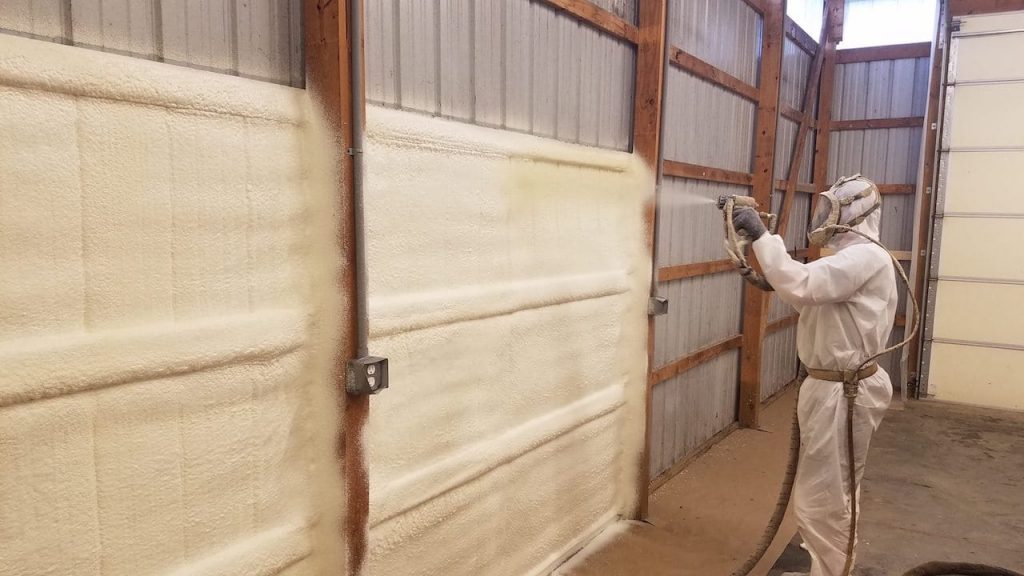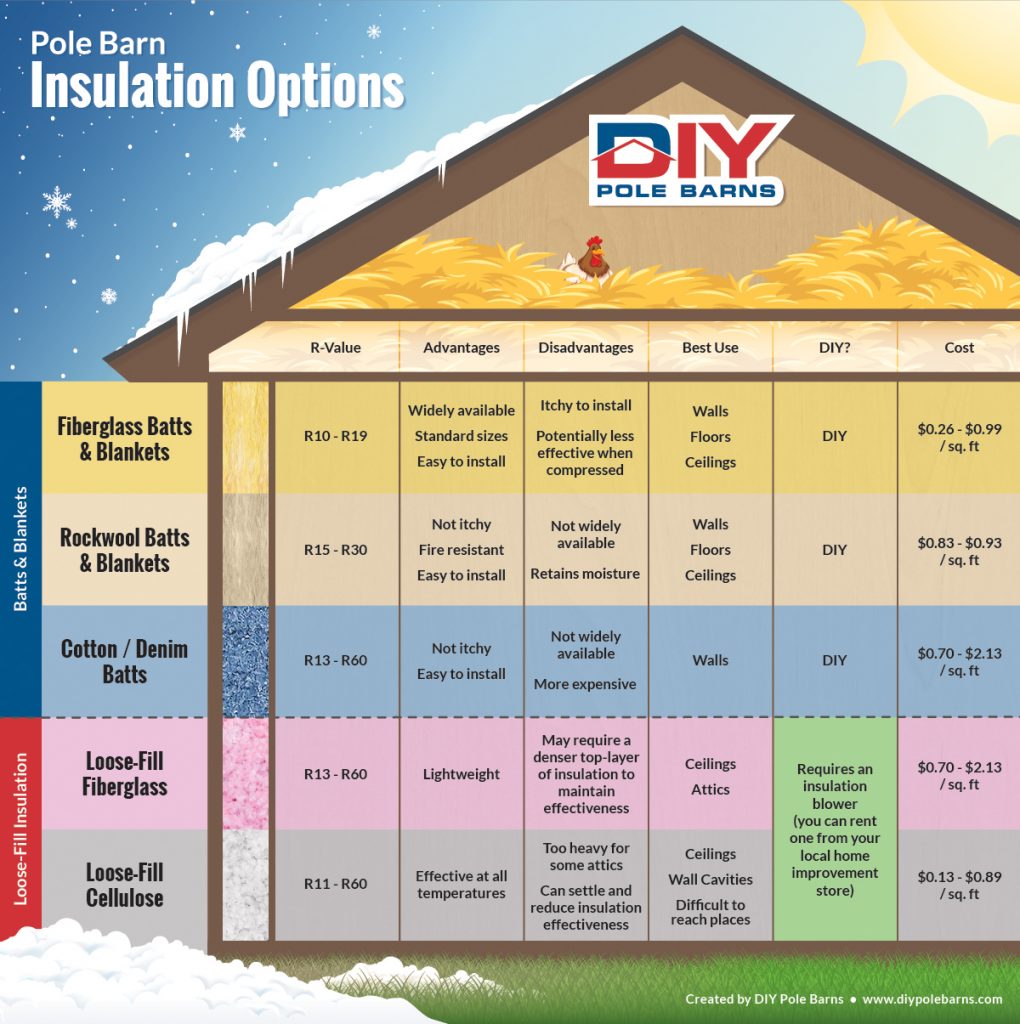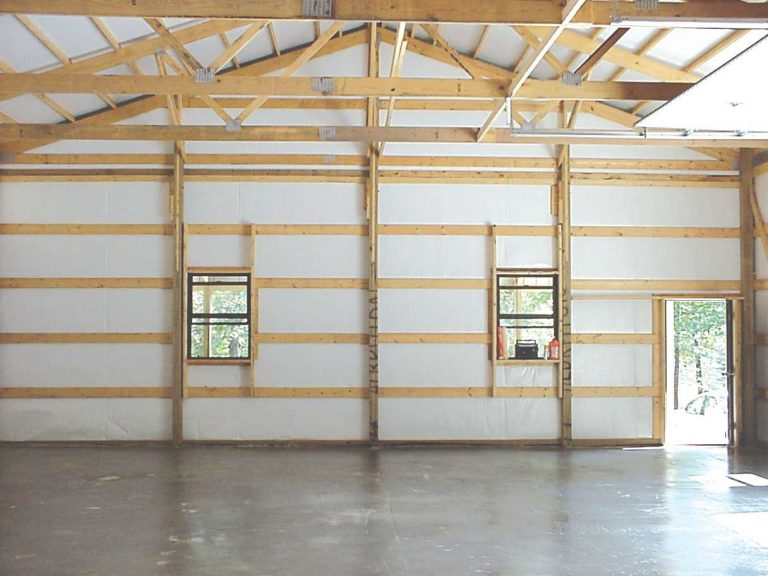Insulating your pole barn is one of the key ways that you can upgrade the livability and comfort your space. Insulation is an important feature that adds comfort and practicality to the space. It also helps reduce the overall costs during the life of your barn and helps keep the air fresh. But you need the right type of insulation, R-value and plan for insulation.
Inaccurate R-value choices, even if you just choose the highest R-value, can lead to heat loss.
Knowing your options, considering the size of your building and knowing why insulation is important is key. This information should dictate your decision on which insulation type to install and where it should be installed.
Why Insulation is Important
If you’re debating whether or not you truly need insulation, there are a lot of great reasons to insulate your pole barn.
#1 – Lowers Energy Costs
Heating and cooling are both major expenses. The larger your space, the more energy will be required to make the temperature comfortable. Adding insulation with the right R-value allows you to reduce your energy costs.
Less air seeps into and out of the space when it’s insulated properly.
You can also add insulation to your ceiling and walls. The better you insulate the space, the eco-friendlier your barn will be.
#2 – Improves Indoor Air Quality
Air quality is important in any building, especially if you have asthma or allergies where mold spores or dust can cause you difficulty breathing. Effective insulation and ventilation will address both of these problems by keeping moisture out of the space and improving your air quality.
Pole barn insulation can also lead to less mold and mildew growth, which can damage a building and allow spores to enter the air.
#3 – Prevents Mold, Rust and Mildew
Mold, deterioration, mildew and rust are common in uninsulated pole barns. The lack of airflow control allows two main culprits in:
- Condensation
- Moisture
As the moisture stays in the pole barn, it will start to damage the building. Rust can begin to set in, mildew and mold can grow, and you’ll eventually lower the integrity of the building. Insulation allows you to control air flow so that your building lasts longer.
Insulating Your Pole Barn

There are a lot of pole barn insulation options that we’ll outline below, but it’s important to know more about the R-value and what it means for your heating and cooling.
R-Value and Your Pole Barn Insulation
The insulation that you install will dictate the air flow, or heat flow, into a space. When choosing an R-value, the higher the value, the less heat loss will occur. You might be tempted to choose the highest option without considering other factors, but this would be a costly mistake.
You should consider:
- HVAC system type
- Size of the space
- Climate zone
Ceiling and wall R-values may be different. It’s important to consider all of your factors and speak with a professional that can recommend an installation that works best for your climate zone and pole barn.
Pole Barn Insulation Options

There are numerous insulation options for a pole barn.
Let’s take a look.
Attic Insulation
Attics are known for being spaces where extreme heat and cool air linger. Blown insulation and fiberglass batts are most common. Blown insulation is a good option because it will provide an airtight installation between the bottom of the trusses and the ceiling joints.
Ideally, an R-38 insulation will be used for the attic’s insulation.
Perimeter Slab Insulation
Concrete flooring, like the flooring in most garages, is a slab that offers its own R-value and insulation. Heat will escape from the space where insulation is poor, such as along the floor or columns.
Installing insulation in these key areas can keep the inside air well-controlled and prevent air from seeping into and out of the garage.
Roof Insulation
Many pole barn owners opt for roof insulation instead of an interior liner package. It’s a great way to help insulate the interior and is usually installed under the roof sheathing.
One of the most common options for roof insulation is Thermax, a rigid board insulation.
The advantage of Thermax and other similar products is that they eliminate the need for drywall or other interior finishes.
Radiant barriers also slow the transfer of heat and can be placed just about anywhere in your building.
Wall Insulation
The walls of your pole barn play an important role in protecting the interior from the elements. Insulation further protects the interior while creating a comfortable environment.
Without wall insulation, conduction would occur and you would spend more on energy costs.
Fiberglass Batts
The most common type of insulation used in post frame structures is fiberglass butts. This is because it’s affordable and easy to install compared to other insulation types.
Fiberglass insulation can be placed in between posts with few air leaks in between panels. If you’re considering this type of insulation, you may also want to consider installing a vapor barrier. A vapor barrier will minimize condensation from moisture build-up that can cause issues down the road.
Vinyl Back
A type of fiberglass batt, vinyl back has a white coating on one side and is typically installed in between the framing. Vinyl back is thinner than traditional fiberglass batts, which means that it has a lower R-value.
Sprayed Polyurethane Foam (SPF)
SPF has become a popular option for insulation and an alternative to fiberglass, although it comes at a high cost. The benefit of SPF is that it easily fills cracks and exposed area of the barn, allowing you greater protection against moisture and drafts.
If you want to go with SPF, you’ll want to hire a professional spray-foam contractor. This type of insulation requires special equipment and care because of the chemicals used.
It’s important to note that SPF products haven’t been approved or tested for steel use. For this reason, some metal suppliers will not provide warranty coverage if you use SPF insulation.
Rigid Board Insulation
Just as the name suggests, rigid board insulation consists of rigid panels that are placed directly underneath your pole barn’s siding. These boards have a high R-value and provide continuous coverage.
If considering this type of insulation, it’s important to choose an option that is designed for exposed applications.
Building Wrap
Although not technically a type of insulation, building wrap is an optional convection barrier that is worth considering. It’s installed underneath the siding of your barn and is very similar to rigid board.
Building wrap works with your insulation to keep the interior of your barn comfortable. It helps filtrate the air and block moisture.
When building a pole barn, insulation is an important consideration. Make sure that you weigh your options carefully to find one that meets your needs and budget.
